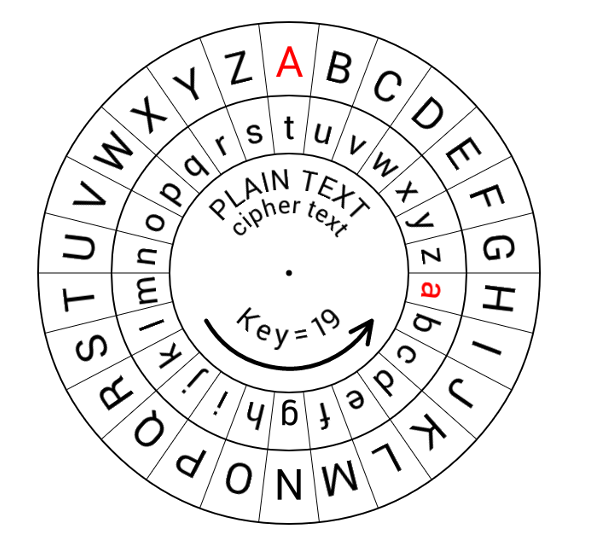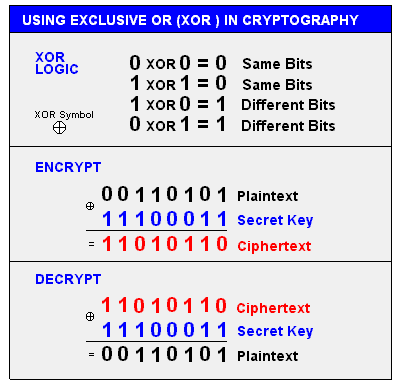Code versus Ciphers
Code
A system that substitutes one word or phrase for another. Codes are intended to provide secrecy and/or efficiency. An example of a code is the "Ten" code which is used by the police and other organizations who communicate by radio
The Ten-Code, also known as ten signals, is a set of code words used to represent common phrases in voice communication, particularly in law enforcement and emergency services.
Here are some examples:
- 10-1: Signal Weak
- 10-2: Signal Good
- 10-3: Stop Transmitting
- 10-4: Acknowledgment (OK)
- 10-5: Relay
- 10-6: Busy
- 10-7: Out of Service
- 10-8: In Service
- 10-9: Repeat
- 10-10: Fight in Progress
Ciphers
A cipher is an algorithm used to encrypt and decrypt information, transforming plain text into coded (cipher) text and vice versa.
- Ciphers ensure data confidentiality
- Central to encryption protocols.
Types of Ciphers:
- Stream Cipher
- Block Cipher
Stream Ciphers
Stream ciphers encrypt data one bit or byte at a time, making them fast and suitable for continuous data flow.
- Encrypts data in a continuous stream instead of fixed blocks
- Uses a key stream generator to create random-looking bits
- The key stream is XORed with the plaintext to get the ciphertext
Stream ciphers are useful for real-time communication, where speed and efficiency are key, but they must use unique and random key streams to stay secure.
For more information, please see Streaming Ciphers.
Block Ciphers
Block ciphers divide data into fixed-size blocks and encrypt each block separately using the same key.
- Encrypts data in blocks, such as 64 or 128 bits
- Each block of plaintext becomes one block of ciphertext
- Can perform transformations like substitution and permutation
Block ciphers typically have 64-bit block size, but in reality its only 56 bits because 8 bits is reserved for overhead/parity to ensure that the other 56 bits are accurate.
For more information, please see Block Ciphers.
Cryptography Techniques
Cryptography protects information by transforming readable data into a secret form and back again. These transformations keep data private and secure during transmission and storage.
- Encryption turns readable data into unreadable form
- Decryption converts it back into its original form
- Two main techniques are substitution and transposition ciphers
Both methods aim to hide the original message while keeping it recoverable only with the right key.
Substitution Cipher
A substitution cipher replaces each part of the message with another symbol or letter based on a fixed rule.
- Each letter or group in plaintext is replaced with another
- A simple example is shifting letters along the alphabet
- Can use a single alphabet or multiple shifting patterns
Example: In a basic shift of 3, A → D, B → E, C → F.
This idea shows how substitution hides meaning by changing characters, not order.
Transposition Cipher
A transposition cipher hides the message by rearranging characters instead of changing them.
- The order of letters changes while letters stay the same
- One example is the rail fence cipher, written in a zigzag pattern
- Another is the columnar transposition, which uses grids and keys to reorder text
This technique scrambles the structure of data, showing that security can come from arrangement, not replacement.
Common Ciphers
Caesar Cipher
The Caesar Cipher shifts letters of the alphabet by a fixed number of positions. It’s one of the oldest and simplest ciphers.
- Each letter shifts a set number of places
- Shifts can be from 1 to 25 positions
- Example: With a shift of 3, A → D, B → E, C → F
- ROT2 means a shift of two positions
- ROT3 means a shift of three positions
Although it's historically significant, the Caesar Cipher is not used for serious encryption today due to its simplicity and vulnerability to straightforward cryptanalysis

Vigenere Cipher
The Vigenère Cipher improves on the Caesar Cipher by using a repeating keyword to determine the shifts for each letter.
- A keyword defines how much to shift each letter
- The key repeats to match the message length
- Decryption uses the same key to reverse the shifts
- Strengths: Adds complexity and resists frequency analysis
- Weaknesses: Patterns in long texts can still reveal the key
Example: Using the key LEMON, the word HELLO becomes OIWWC. The Vigenère Cipher shows how layering keys adds strength to encryption.

Book Cipher (Running Key Cipher)
The Book Cipher, also called the Running Key Cipher, is a type of polyalphabetic substitution cipher that uses text from a book or document as the key. In this cipher, each letter of the plaintext is shifted based on the corresponding letter in the key text
- The book or text is known to both sender and receiver
- The longer the key text, the harder it is to break
- The same book and edition must be used for encryption and decryption
Example:
If the message is "HELLO" and the book text starts with "WORL...", each plaintext letter is shifted by the alphabet position of the corresponding book letter.
Strengths
- Offers stronger security than short-key ciphers like Vigenère
- Key is hard to guess if the book is unknown
Weaknesses
- Vulnerable if the book is identified or reused
- Requires both parties to have identical copies of the text
This cipher shows how using long, natural-language keys can strengthen substitution methods while keeping encryption manual and simple.
Exlusive OR (XOR)
XOR is a basic operation that compares bits and returns 1 if they’re different, or 0 if they’re the same.
- If bits are different, the result is 1
- If bits are the same, the result is 0
- Reversing is easy — XOR with the same key again restores the original
Example:
1 XOR 0 = 1
0 XOR 0 = 0
1 XOR 1 = 0

Applications
- Encryption: Used in stream and block ciphers
- One-Time Pad: A perfect encryption if the key is random and used once
- Error Detection: Helps identify bit errors in data
Security Notes
- Key secrecy is critical for XOR security
- Reusing keys makes it vulnerable to attacks